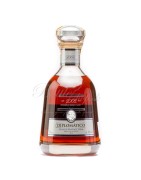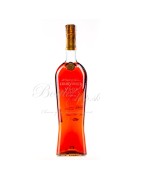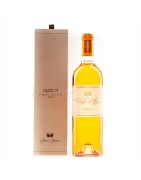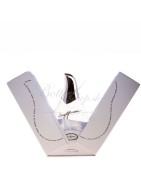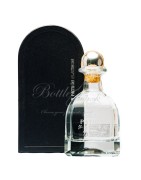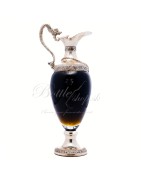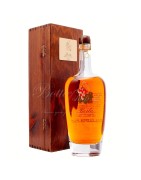Collector's alcohol
Collectable alcohol offers enthusiasts of distilled temptation an even greater pleasure than classic alcohol. It is used to be bought by connoisseurs who, in addition to the taste buds, also want to please the eyes and their own collection.
Today, collectible alcohol bottles are often seen as an investment in art and increase in value over time. Many of them are packaged in exclusive packages or are a work of art in themselves.
Collector alcohol is often also a limited edition, which is often inspired by historical figures or events, or modern trends such as e.g. series Game of Thrones. It is not uncommon for there to be only a few thousand bottles in circulation, or even only hundreds or dozens. In our e-shop you can also find, for example, such a gem as whiskey Duncan Taylor Glenlivet 1968 Rare Auld. Only 151 bottles of it are available around the world, and its price rises to five thousand euros.
Collectable alcohol is also a great idea for a gift. In this way, you give something really special to the recipient and show him that you appreciate him. Thanks to the collector's editions, you can delight lovers of a particular brand of alcohol with an exceptional piece that they do not yet have at home, or would not have bought it themselves.
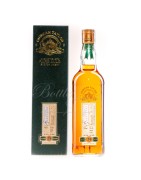
Subcategories
-
Rum
Rum is currently one of the most popular alcoholic beverages both in the world and in Slovakia. It also gained its popularity due to the fact that as soon as you drink from it, it is as if you have immediately moved to a sun-drenched beach in the Caribbean. Come on, who wouldn't want to experience that?
-
Cognac
Every cognac is a brandy, but not every brandy can be a cognac. It is a distillate made from grapes grown only in the Cognac region (France). The name cognac is protected by international agreements exclusively for brandy from this region. Brandy fired elsewhere, though in the same way, is called brandy. Cognac differs from its relative Armagnac by double distillation, a narrower range of grape varieties used, and the size of the region and appellation from which it originates. The Cognac region is larger than Armagnac and since 1908 has been divided into six appellations: Grande Champagne, Petite Champagne, Borderies, Fins Bois, Bons Bois and Bois Ordinaires.
The ancient method of double distillation of cognac in copper cauldrons has a complicated procedure. The separation of several liquid fractions must be strictly followed. The process takes 16 to 24 hours for one "batch". Distillation of the entire harvest must end by March 31 (the closest after harvest). Then the clear distillate with a strength of 70% alcohol goes into oak barrels. The high volume of alcohol is reduced gradually, at different time intervals (according to the determined maturation period). The peak of cognac maturation is 50 years. After 60 years, cognac gains almost nothing from the wood of the barrel, the quality may even deteriorate. Matured cognac is poured into glass demijohns, where it no longer matures. Mixing a marketed mixed drink is an accomplished science. Some also contain more than a hundred cognacs of different ages and tastes. The result reflects the art and taste of the master blender. High-quality cognacs are bottled, which are a gem in themselves. The first-class quality of the drink is combined here with a work of art.
Cognacs are indicated by letters or names according to the age of the mixture and according to the youngest brandy in the mixture. In In 1865, Maurice Hennessy compiled the official scale that is still used today:
V.S. - Very Spéciale – a mixture of cognacs, the youngest of which is at least 2 years old
V.S.O.P. - Very Superior Old Pale – a mixture of cognacs, the youngest of which has min. 4 years
X.O. - Extra Old – a mixture of cognacs, of which the youngest mixture has min. 6 years (from 2018 min. 10 years)
However, producers use significantly older types of cognac than the minimum required and therefore distinguish the cognacs with other names:
Napoleon – ranks between VSOP and XO cognacs
Extra – ranks above XO cognacs
Hors d'Age - refers to high-quality cognacs that are even 100 years old
Vintage - vintage cognacs, the mixture is from one year -
Whisky
So whiskey or whiskey? You will learn that too. But the most important thing is that it is a distillate made from cereals and aged in barrels - most often oak - for at least 3 years and 1 day. For centuries, whiskey was divided into malt (malt) and grain (grain), until in 1863 William Sanderson presented what is said to be the first blended whiskey in the world. When you hear the word whisky, you automatically think of Scotland. Not by chance. Whiskey is not only a rare export item for Scotland, but also one of its symbols. But when we follow the traces of the origin of whiskey, we find that the Scots were probably not the first to burn it. This honor is claimed by their Celtic relatives - the Irish. However, as the true Scots say: "The Irish may have invented whiskey, but the Scots perfected it!" There are also known theories that the Welsh were the first to make alcohol from malt. The name whiskey comes from the Celtic term "uisge beatha" - water of life. By gradually shortening, "usky" changed until it reached "whisky".
The oldest mention of whiskey comes from the 6th century, from the so-called Columba's Codex - the books of punishments that the Irish abbot Columba imposed on priests and monks who worshiped "uisge beatha" excessively. However, the first written mention of the production of whiskey from malt dates back to 1494. Until then, the "water of life" was distilled only from wine. Scotch whiskey is characterized by a smoky aroma and taste, created by drying malting barley over an open peat fire. It is distilled twice. The Irish do not use peat fire for malting, so Irish whiskey lacks the typical smoky note. During its production, raw barley is mixed with malt and roasted three times.
The term whiskey is also used by American products, produced mainly from corn and known as U.S. whiskey, Tennessee whiskey or Bourbon. Canadian whiskey is also popular among connoisseurs, but Japanese whiskey is also gaining more and more popularity. And we are at the beginning - so when whiskey and when whiskey? The established rule among manufacturers is that in countries whose name contains "e" (UnitEd StatEs of AmErica, IrEland) they use the name whiskEy. Countries without an "e" in their name (Canada, Scotland, Japan) produce whiskey. -
Wine
Wine is fermented grape juice. Simple. However, if it were really that simple, we wouldn't need experts to make it. More than one domestic "vincúr" has already convinced himself of this. In reality, however, wine is the result of a complex process, containing many simple actions. And it is precisely because of the complexity of this process that wine is such a fascinating drink. Each wine tastes different despite the fact that individual producers may have used the same grape varieties from the same quality vineyards with the same climatic conditions. That's the little wine miracle. Wine can also be made from other fruits or herbs. In that case, its name must be supplemented with the type of fruit, or labeled generally as a fruit wine. The very word wine on the label always indicates wine from the vine. Since the Slovak wine lover has relatively easy access to good wine, on our website we mainly offer less affordable but very high quality wines. Not excluding fruit.
-
Vodka
It is one of the most widely used spirits in the world. Vodka can be made from any vegetable raw material rich in starch or sugar. Currently, sorghum, corn, potatoes, molasses, soybeans, fruit, rice or sugar beet are often used. However, the best distillates are made from rye and wheat. Russia, Poland, Finland, Sweden - these are countries that have made vodka production almost an art. In the USA, vodka was Virtually unknown in 1940, today it is also among the popular spirits there. Standard Ukrainian, Polish, Russian, Latvian and Lithuanian vodkas contain 40-75% alcohol. The European Union set a minimum alcohol content of 37.5% for vodka, the USA 30%. Historians are still not clear when and where vodka began to be produced. According to some sources, it should have been in the territory of today's Russia in the 9th century, other sources indicate that it happened in Poland in the 8th century. Vodka was initially used as a medicine, it had a different taste, color and smell and a low alcohol content, because the technology of natural fermentation could achieve max. 14%. It was only after the discovery of distillation that "hard" alcohol came along. The first distillery (vinokurnya) for the production of vodka was documented only in 1174 in the chronicle of the city of Vyatka, then Khlynovska (Russia). The name "vodka" is a diminutive of the Slavic word "voda". It can be interpreted as "little water" or "little water" (a lot of alcohol). The word vodka was first recorded in 1405 in Poland (court documents Akta Grodzkie). Back then, it referred to a chemical compound used as a medicine or cleaning cosmetic, while a popular drink in Poland was called gorzałka. The word vodka written in the alphabet appeared for the first time in 1533 in relation to a medicinal drink that was transported from Poland to Russia by merchants from Kievan Rus. In Central and Eastern Europe or around the Baltic Sea, vodka is mainly drunk neat. Vodkas with fruit powders are very fashionable and popular today. Elsewhere, vodka is mainly used to prepare cocktails and mixed drinks. It is an important part of drinks such as Bloody Mary, Sex on the Beach, Moscow Mule, White Russian, Black Russian... Tip for preparing sugar syrup We use sugar syrup when preparing almost every cocktail. We can never add pure sugar. Cocktails with sugar syrup are smoother and tastier and have a better consistency. Sugar syrup cannot be replaced even by industrially produced fruit syrup. If we don't want to buy syrup, we can make it at home. To make 1/2 l of sugar syrup, we need 1/2 kg of granulated sugar and 3/8 l of cold water. We will get a basic tasteless syrup. All containers used must be perfectly clean. Pour sugar into a stainless steel or enamel pot, cover with water and dissolve. We put it on the fire, bring it slowly to the boil and stir occasionally. When the mixture starts to boil, sprinkle it with cold water so that the foam that forms on the surface falls off. We collect the foam that remains. Then cook the mixture for about 5 minutes. We will have approximately 1/2 liter of pure sugar syrup. Pour the syrup through a fine sieve or a clean thick cloth into a jug or porcelain mug, and after it cools down, you can pour it into bottles, close it well and store it in the cold. If we had boiled the syrup for two or three minutes longer, it would have been thicker and would not have lasted for a long time, just like honey, it would have crystallized soon in the bottle. Let the syrup cool down and use it to make cocktails.
-
Tequila
Tequila is a strong alcoholic drink produced mainly around the city of Tequila in the Mexican state of Jalisco. It is distilled from 10-year-old Agave tequilana plants (Weber's blue agave). The most common types of tequila contain 38-40% alcohol. We know two basic types of tequila. Tequila 100% agave and tequila mixto. An alcoholic drink marked with the inscription 100% agave is a pure distillate from blue agave and can only be found exceptionally in Slovakia. This mark is, so to speak, a certificate of quality. The drink does not contain any additives and can be in Blanco, Reposado, Anejo or Extra Anejo versions. Tequila mixto is not a distillate, but a spirit. Although it is made from agave, cheaper sugar cane is also added to it. Therefore, the agave taste is weaker and the drink is not as smooth as 100% agave tequila. Tequila can only be produced in five regions of Mexico. Throughout the state of Jalisco and in certain areas of the states of Guanajuanto, Michoacán, Nayarit and Tamaulipas. The cultivation of agave and the production of tequila in Mexico is strictly regulated by law and thoroughly controlled. 100% agave tequilas are not drunk with salt, lemon or orange, as is customary in our country, but neat or in combination with sangrita, a special fruit and vegetable juice. In Slovakia, however, tequila mixtos have caught on in particular. Olmeca is among the most popular. Quality tequila reposado has a delicate golden color with a hint of vanilla and cinnamon in the taste. Tequila reposado is usually lighter than tequila gold, but it is of higher quality. The most mature tequilas include Anejo and Extra Anejo. They are typical dark, aromatically rich and complex tasting tequilas.
-
Liqueur
The word liqueur comes from the Latin liquifacere (to dissolve), which points to the importance of dissolving the flavor components of the used raw materials in alcohol. Liqueurs are usually not aged, but they can stand for a certain time during production so that their components are properly combined. They are mostly intended for direct consumption. The production of liqueurs was already widespread centuries ago, when they were separated from herbal medicine. In Italy, liqueurs were produced already in the 13th century. There are many types of liqueurs with different alcohol content - herbal, coffee, chocolate
-
Grappa
Grappa, an aromatic distillate with an alcohol content of 37.5% to 60%, is an Italian specialty that is mainly served as a digestif after a meal. It is named after the town of Grappa from the Veneto region, Bassano del Grappa. Grappa is made from grape marc - the solid residue that remains after the woody parts of the grapes have been pressed. Since 1951, the word grappa has been exclusively reserved by law for a distillate made from grape marc. It is therefore not possible to distinguish French, German or Austrian grappa. On offer are unique grappas such as Grappa Bianca Ampolla Selezione, Nonino Cuvée 2012 and Frattina Grappa di Moscato d'Asti.
-
Gift alcohol
Choose from exceptional bottles that have matured for decades. Here you will find delicious whiskey, brandy, rum and other exceptional spirits for your loved ones or friends who are celebrating their birthdays.
Active filters
- Brand: Nikka Whisky

